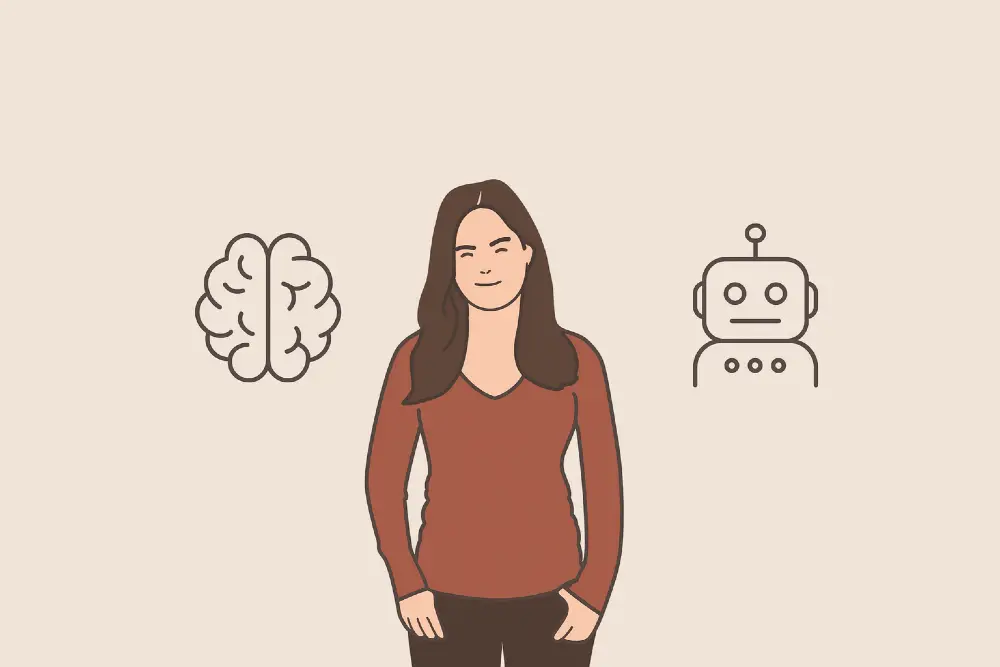Stop cognitive offloading: How lazy AI use is killing B2B marketing results
Marketing Director Joel Zorrilla warns against using AI in ways that reduce critical thinking—and shares what actually works for lead generation in complex industries

Most B2B marketers are using AI to make themselves dumber.
They're engaging in what Joel Zorrilla calls "cognitive offloading"—asking ChatGPT to write a blog about B2B marketing, copy-pasting the result, and wondering why it tanks. "It's going to have a lot of mistakes. It's not going to have data to back it up. It's going to be obvious it was written with ChatGPT," Joel warns.
Cognitive offloading means using AI in a lazy way that reduces your critical thinking skills. And it's everywhere in B2B marketing right now.
Joel would know. As Marketing Director at Wayfindr, a Hong Kong-based fourth-party logistics (4PL) company that manages the entire supply chain for e-commerce brands, he's spent years figuring out how to market complex services to skeptical buyers. Wayfindr, which rebranded from CBIP Logistics in mid-2025, describes itself as Asia's first carbon-neutral 4PL provider, handling everything from freight and warehousing to fulfillment and last-mile delivery across North America, Europe, and Asia Pacific.
Before joining Wayfindr full-time in October 2025, Joel worked with the company on and off for several years as a consultant, while also holding roles at InCorp Indonesia & Vietnam (market entry services) and FailFighters (a sustainability platform). His specialty: making complex B2B businesses understandable, then turning that clarity into leads.
His track record speaks for itself. At InCorp, he inherited a disaster—traffic and leads plummeted 90% in one week after a Google algorithm update. With minimal budget, he rebuilt everything from scratch and recovered traffic within six months. At Wayfindr (then CBIP Logistics), he transformed their marketing approach and achieved 10x ROI, including landing Bloomberg journalist quotes for the founder.
Now, as AI reshapes marketing, Joel is adapting those hard-won lessons for a new era—while watching most marketers make the same mistake.
Short on time?
- How to use AI without cognitive offloading
- Why most agencies still can’t market complex B2B industries
- The messaging problem killing your leads
- What's working in 2025 and beyond
How to use AI without cognitive offloading
"Five years ago, we had a really good team of writers, and that was our advantage," Joel reflects. "But now everybody's a writer because everybody's pumping out content. The competition is 10, 20 times higher."
The democratization of content creation through AI has made those old advantages less effective. But it's also created a new problem: cognitive offloading.
Instead of lazy copy-pasting, Joel advocates strategic AI usage across four key areas:
- Content structure and research: Use AI to create blog outlines and source supporting data. Claude excels at research and creating comparison tables that make dense information digestible.
- Repurposing content: This is where AI truly shines. A 1,500-word blog can become a LinkedIn carousel, an audio podcast (using ElevenLabs), or an interactive podcast with two speakers (using Google's NotebookLM). "Don't just write a blog and publish it," Joel emphasizes. "Turn that into a carousel. Turn that into audio. Turn that into a podcast. You can be sitting on a goldmine and you don't realize that."
- AI tool specialization: Different platforms excel at different tasks. Joel subscribes to paid versions of Claude (research, tables), ChatGPT (repurposing, custom GPTs), Perplexity (comprehensive research), and Google AI Studio's NanoBanana (brand-aligned illustrations). "I just discovered NanoBanana a week ago," Joel notes. "It's really good at creating illustrations in line with your brand guidelines. If you're a graphic designer, I'm sorry, maybe it's time to find a new job."
- Interactive lead magnets: Traditional PDFs are becoming obsolete. Joel is building interactive micro-SaaS tools embedded directly on websites. For Wayfindr, he's developing a shipping cost calculator—offering substantially more value than a static PDF guide. Tools like Lovable AI and Vibe Coding now enable non-developers to create functional micro-SaaS applications. "That's the future of lead magnets," Joel says.

Why most agencies still can’t market complex B2B industries
The fundamentals that drove Joel's pre-AI wins—understanding complex business models, clarifying messaging—remain essential. But 90% of agencies still don't do them.
Joel identifies one critical error that plagues 90% of boutique and medium-sized agencies: they lack a systematic process for understanding complex business models.
"Complex means it's not easy to understand. If you're writing content or running ads, you have to become an expert in whatever that is," Joel explains. "A lot of agencies don't have a way of learning and transmitting that knowledge to their stakeholders."
For Wayfindr, Joel and his writer spent considerable time becoming logistics experts—understanding the specific 4PL model, not just general shipping concepts. This depth of knowledge affects everything from Google Ads keyword selection to content priorities.
"If you have a Google ads expert running ads, they have to understand the high priority versus low priority products and keywords. They have to understand the nuances."
How do you know when you've learned enough? Client feedback provides the clearest signal. "In the beginning, the client's going to say 'no, that's wrong' constantly. After two or three months, that feedback should be cut down by 80% at least. Otherwise, you're not learning."
The messaging problem killing your leads

When B2B companies struggle with lead generation despite having traffic, the problem typically lies in messaging. Joel's first step is conducting a "brand story audit"—examining how a company talks about itself across all touchpoints.
"If I land on a website and if I immediately don't understand what they do, what their offering is, and what their unique value proposition is, I'm probably going to leave," Joel explains. "I have a five-second rule. Within five seconds, I have to understand what you do, how you do it, what value it brings to me, how it works."
The brand story audit functions as messaging guidelines—similar to visual brand guidelines, but focused on communication. "If people are having lead flow issues, look at your messaging," he advises. "You're probably confusing your visitors. Make the customer the hero of the story, and write about your products or services in a super simple way that those potential customers understand."
When companies attract traffic but fail to convert, Joel points to two primary culprits: unclear messaging and inadequate testing. "You have to look at your brand messaging. If you have a lot of traffic but you're not converting, there's something wrong with your titles, descriptions, product descriptions."
Beyond messaging clarity, he advocates for rigorous A/B testing—creating two versions of landing pages with different messaging and splitting traffic 50/50 to measure which converts better.

What's working in 2025 and beyond
Looking ahead, Joel emphasizes preparing for rapid change. "We're living in the modern version of the Industrial Revolution. AI is moving really fast. Marketing now is 10 times harder than it was four or five years ago."
The primary challenge: dramatically increased competition. "Five years ago, we had a really good team of writers, and that was our advantage. But now everybody's a writer because everybody's pumping out content. The competition is 10, 20 times higher."
His recommendations for B2B teams building AI-assisted marketing engines:
- Focus relentlessly on quality: This remains a differentiator when AI makes basic content production universal. Quality requires deep industry knowledge, original insights, and genuine value creation—areas where AI assists but doesn't replace human expertise.
- Stay current with AI developments: Joel discovers new capabilities weekly. Subscribe to newsletters, follow thought leaders on LinkedIn, and experiment with new tools as they emerge. "Every week, these things are changing. AI is moving so fast. It's really important to stay ahead of the curve."
- Optimize for AI-powered search: Consider how ChatGPT, Perplexity, and Claude will surface and cite your content. AI overviews and natural language search are changing SEO fundamentals.
- Prepare for micro-SaaS lead magnets: Traditional PDFs are becoming obsolete. Start learning to create interactive tools that provide genuine utility to prospects.
"You got to look at it holistically. You got to be much smarter about it," Joel concludes. "Marketing is constantly evolving. You really got to predict the future and always stay up to what's happening with the latest trends."
For university students considering marketing degrees, Joel is blunt: "I think it's useless to study marketing in university, because by the time you graduate, everything you learned has been expired."
The only viable path forward: continuous learning, strategic AI adoption, and unwavering focus on delivering genuine value in an increasingly noisy digital landscape.
This interview was conducted in September 2025. Since the interview, Joel Zorrilla joined Wayfindr full-time as Marketing Director in October 2025.




